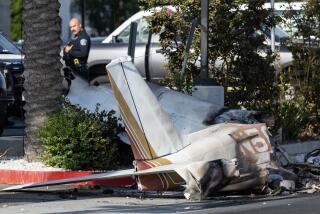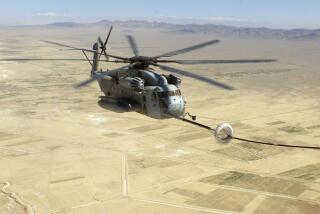Crack in Copter Tail May Have Led to Crash
A tiny crack that apparently led to the disintegration of the tail rotor is emerging as the most likely cause of last week’s Los Angeles Fire Department helicopter crash that killed three crew members and the 11-year-old girl they were rushing to a hospital.
A laboratory examination of crash wreckage found the fatigue crack in the tail yoke assembly, which secures the helicopter’s two tail rotor blades and connects them to the drive shaft, according to a preliminary report released Wednesday by the National Transportation Safety Board.
Richard Wright, director of safety and flight operations for Helicopter Assn. International in Alexandria, Va., said it appears that a fracture resulting from the crack may have caused the breakdown and subsequent disintegration of the entire tail rotor assembly.
Without a tail rotor, the helicopter apparently began to spin, spiraling down before crashing into a wooded hillside in Griffith Park at 7:38 a.m. on March 23.
Still unanswered is the question of what caused the fatigue crack.
Wright said corrosion or something striking the tail rotor could have caused the crack, but he stressed that a microscopic study of the yoke assembly must be completed before any determination can be made.
Wright said that detecting the crack during routine maintenance might have been extremely difficult, and fire officials agreed.
“Unless you’re Superman, you can’t X-ray it,” said Les Iden, assistant general manager for the General Services Department, which is responsible for maintenance of the helicopter fleet. “When you’re doing a walk-around [inspection], it’s a visual check. You’re looking for a big dent or a ding or a crack. If you don’t see anything, it passes inspection.”
Assistant Fire Chief Dean Cathey said that if the part that cracked “was within its normal life expectancy, it raises potential questions about whether we need to look at some kind of accelerated maintenance, as a precaution.”
Cathey said the city would await guidance from the aircraft’s manufacturer, Fort Worth-based Bell Helicopter, on whether to replace certain parts more frequently.
Safety board officials have yet to review the aircraft’s maintenance records and interview pilot Steven L. Robinson, who suffered a skull fracture in the crash and has been unable to recall many details, chief investigator Wayne Pollack said.
“We’re not there yet,” Pollack said.
He said he expected to file a fuller report on the crash within six months.
Although brief--and issued without comment or amplification--Wednesday’s report provided the most complete picture so far of the aircraft’s ill-fated rescue flight.
Two minutes after landing at the Stonehurst Elementary School playground, near the car accident that injured 11-year-old Norma Vides, the helicopter lifted off and began heading straight for Childrens Hospital.
But six minutes into the flight, Robinson broadcast that he was beginning to lose control of the aircraft, known to air traffic controllers as Lifeguard Fire 3.
Wright said that at that point, the tail rotor assembly, weakened by the crack, apparently was beginning to tear itself apart.
“There’s one heck of a lot of force in that tail assembly, and when you have a failure of the yoke or any other major component, there’s a possibility that you’ll have catastrophic failure of the whole thing,” he said. “In this case, it appears that’s what may have happened.”
The two rotor blades and a gearbox to which they are linked were later found on parkland about a mile north of the crash site.
A helicopter’s tail rotor is designed, in large part, to counteract the twisting motion of the main rotor, Wright said. He said that without a tail rotor, the helicopter would have begun to spin, faster and faster, in the same direction as the main rotor that suspends and propels the aircraft.
“It’s one of the most catastrophic emergencies that a pilot can be faced with,” Wright said. “With the aircraft spinning, after two revolutions, it’s hard to know which way is up. . . .
“You should try to disengage the engine and attempt auto-rotation (a technique in which a pilot uses air resistance generated by the pinwheeling main rotor to cushion the aircraft’s fall),” Wright said. “That reaction has to be almost immediate. You’ve got a real bad situation on your hands.”
Witnesses said the red and white Bell 205A-1 helicopter clipped several tall pine and redwood trees before slamming into a small patch of grass near Fern Dell Drive.
Those killed included Norma, paramedics Michael A. Butler, and Eric F. Reiner, and crew member Michael D. McComb. Robinson and another crew member, Dennis J. Silgen, were severely injured and remained hospitalized Wednesday.
More to Read
Sign up for Essential California
The most important California stories and recommendations in your inbox every morning.
You may occasionally receive promotional content from the Los Angeles Times.










